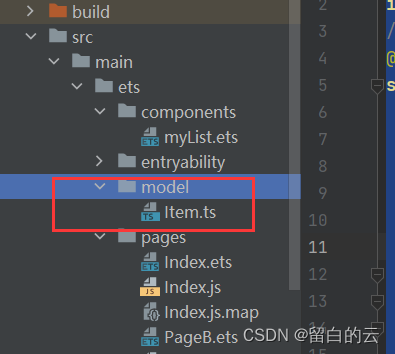1.条件渲染
ArkTS提供了渲染控制的能力。条件渲染可根据应用的不同状态,使用if、else和else if渲染对应状态下的UI内容。
当if、else if后跟随的状态判断中使用的状态变量值变化时,条件渲染语句会进行更新。。
@Entry
@Component
struct PageIfElse {@State list: Object [] = []build() {Row() {Column() {Button("onClick").onClick(()=>{this.list=[{ id: 1, name: "房子",type:1 },{ id: 2, name: "车子",type:2 },{ id: 3, name: "票子",type:3} ,{ id: 1, name: "理想",type:1 },{ id: 2, name: "现实",type:2 },{ id: 3, name: "梦想",type:3}]})if(this.list.length){List(){ForEach(this.list,(item:Object)=>{ListItem(){getOrder(item)}.margin(10)},item=>JSON.stringify(item))}.height(200)}else{Text("三无青年")}}.width('100%')}.height('100%')}
}@Builder
function getOrder(item){Row(){Text(item["name"]).fontSize(18).fontColor("#333333")if(item["type"]==1){Text("一座").fontSize(19).fontColor(Color.Red)}else if(item["type"]==2){Text("二辆").fontSize(19).fontColor(Color.Red)}else if(item["type"]==3){Text("三捆").fontSize(19).fontColor(Color.Red)}}.justifyContent(FlexAlign.SpaceBetween).width("100%")
}2.自定义组件
在ArkUI中,UI显示的内容均为组件,由框架直接提供的称为系统组件,由开发者定义的称为自定义组件。在进行Ul界面开发时,通常不是简单的将系统组件进行组合使用,而是需要考虑代码可复用性、业务逻辑与UI分离,后续版本演进等因素。因此,将UI和部分业务逻辑封装成自定义组件是不可或缺的能力。
自定义组件具有以下特点:
1、可组合:允许开发者组合使用系统组件、及其属性和方法。
2、可重用:自定义组件可以被其他组件重用,并作为不同的实例在不同的父组件或容器中使用。
3、数据驱动UI更新:通过状态变量的改变,来驱动UI的刷新。
struct:自定义组件基于struct实现,struct +自定义组件名+..}的组合构成自定义组件,不能有继承关系。对于struct的实例化,可以省略new。
@Component: @Component装饰器仅能装饰struct关键字声明的数据结构。struct被@Component装饰后具备组件化的能力,需要实现build方法描述UI,一个struct只能被一个@Component装饰。
@Entry: @Entry装饰的自定义组件将作为UI页面的入口。在单个UI页面中,最多可以使用@Entry装饰一个自定义组件。
build()函数中需注意: build()函数用于定义自定义组件的声明式UI描述,自定义组件必须定义build()函数。
build()函数下的根节点唯一且必要,且必须为容器组件,其中ForEach禁止作为根节点。build()函数下:
1、不允许声明本地变量。
2、不允许在UI描述里直接使用console.info(),但允许在方法或者函数里使用。
3、不允许调用没有用@Builder装饰的方法。
4、不允许switch语法,如果需要使用条件判断,请使用if。
5、不允许使用表达式,比如三目运算。
代码示例:
自定义组件需要新建一个components的文件夹。将自定义组件拷贝在里面。

import Item from '../model/Item';
//自定义组件 组件与组件之间是隔离的
@Component
struct myList {private item: Item;private index: number;private list: Item [];@State isChecked:boolean =falsebuild() {Row() {Checkbox().onChange(v=>{console.log(v.toString())this.isChecked=v})Text(this.item.text).fontSize(20).decoration({type:this.isChecked?TextDecorationType.Underline:TextDecorationType.None,color:Color.Blue})Button("删除").backgroundColor(Color.Red).onClick(() => {this.list.splice(this.index, 1)})}.justifyContent(FlexAlign.SpaceBetween).width("100%")}
}export default myList
自己新建的对象需要新建一个model文件夹。对象是普通的ts文件。
class Item {id: number;text: string;constructor(id: number, text: string) {this.id = idthis.text = text}
}export default ItemDEMO运行效果如下

自定义组件demo如下:
import myList from '../components/myList'
import Item from '../model/Item'
@Entry
@Component
struct PageIfElse {@State text: string = ''@State list: Item [] = [new Item(Date.now(), "房子"),new Item(Date.now(), "车子")]build() {Row() {Column() {Row() {TextInput({ text: this.text }).width(250).onChange((value) => {this.text = value})Button("增加").onClick(() => {this.list.push(new Item(Date.now(), this.text))this.text = ""}).margin(10)}.width("100%").justifyContent(FlexAlign.SpaceBetween).margin(10)List() {ForEach(this.list, (item, index) => {ListItem() {myList({ item, index, list: this.list })}.margin(10)})}.layoutWeight(1).divider({strokeWidth: 1,color: Color.Blue,startMargin: 10,endMargin: 10}).width('100%')}}.height('100%')}
}

)




)






)

打开)


